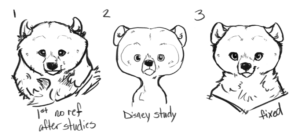How to get the Most out of Art Studies
In the last few days, I've been finding time to do a few art studies of bears. I wanted to write a blog post about how I approach studies and their benefits.
Benefits
1. Studies give you practice. Very obvious.
2. Studies build your "artistic library." I first heard this term coined by Jake Parker in one of his youtube videos. He's an amazing artist with amazing work ethic and perseverance. Super inspirational to watch. I don't have adequate words to describe how helpful he's been to the online art community. Check out his Youtube!
Study with my notes
Your artistic library is the collection of skills you earn when learning to draw. It's the memory and understanding of the anatomy and simple shapes that make up a subject, and how you are able to apply them when drawing without reference (and with reference, too, explained in the 3rd benefit). My personal aim is to be able to draw a bear decently without reference and not have it look like a big fluffy dog.
You can build your artistic library by not only drawing from photo references, but also from studying other artists. Ask yourself "why" they made certain choices about anatomy. Constantly flip between their art and a photo reference to help clarify what features they decided to accentuate in their drawing. I suggest attempting to draw on your own after the studies, applying what you learned and what you like. That's how your own unique style begins to form.
An example of how I applied what I learned from a study is posted below in my "process."
3.) Studies gave me confidence and clarity. I used a screenshot from the Disney movie Brave of one of Merida's little brothers as bear cubs. (They're really adorableeee.) I was pretty happy with my study from Disney. I realized, "Hey, I've gained the skill to at least replicate something I see decently. It's just my artistic library that needs to be filled." Basically, I need to do more studies.
At this point in my art journey, I feel that I can draw most things decently with a reference...better than I could a few years ago. That's a skill artists will forever work on, so don't ever be worried about your progress.
I found that I not only use my mental library when I don't have references, but it also helps me understand what I'm looking at when I DO use references. Because I've built up some sort of a library of anatomy and shapes in my head through practicing before, I know what to look for. I'm more familiar with the motions of sketching what I see.
WHAT I SEE
My Process
1.) After I choose the subject I want to study (in this case bears), I'll find a few photo references that I fancy. I'll usually sketch from the same photo reference quite a few times (about 5+) until I feel that I'm happy with it or when I'm starting to understand anatomy from that angle. This usually applies to things I haven't drawn before or if I feel that I lack understanding of anatomy for the subject.
You do you. I would recommend practice until you feel proud of yourself or just happy with it! If you're trying to improve, you're doing it for yourself, so only you can make that call.
2.) I'll look up concept art for movies and video games that I remember had bears in them. I'll try to observe what the artist was trying to accentuate about the bear to make it a "bear." I had to work at my initial sketch for a while until I figured out how to make sure the bear didn't look like a dog. I took note of things like: the long forehead, ears on the side of the head instead of on the top, small close eyes, blocky snout.
3.) I'll fix my sketch(es) accordingly. After drawing a few more studies, I went back to one I drew without reference and fixed a few features that I learned from using references. You can see the progress below!
Last one fixed using what I learned from the studies
What I Fixed
I noticed the ears were too tall, pointy, and still somewhat on top of the head. I re-sketched the eyes and the area around them to keep them cleaner looking (which I suppose is a personal/stylistic choice), fixed the head to be more flat and boxy shaped. Also I noticed that bear cubs don't have as much neck scruff as the adults. The fixed one took me a while. I kept flipping the canvas in Photoshop to make sure everything looked somewhat even.
Testing myself without references, and returning to fix mistakes is how I get the most out of my art studies.
*Disclaimer: This is my process of thinking. Everyone has different learning styles, but I'm hoping to give some insight on how to analyze references and think critically during art studies. It helps me notice my mistakes way faster. I still have so much to learn, and I will most likely see things differently in the future as well.
Thank you for Reading!
Thank you! Please share in the comments if you have any other ways that help you study more efficiently! Now I'm eager to try to learn how to draw those large bear claws!
Good luck with your artistic endeavors!
Addie


